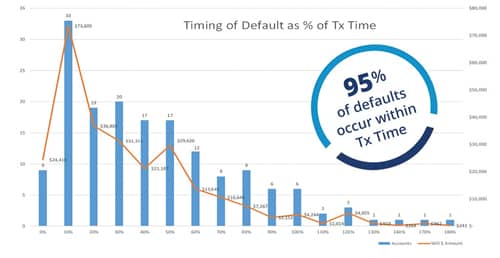Q: What’s all the hype over same day starts? Why are they so important?
A: People today are highly distracted. Once a person leaves the office and becomes “pending,” you are competing with all manner of other distractions and expenses which diminish their likelihood of deciding to start treatment in your office. The reality is that many other things compete for patient dollars besides orthodontics. We have irrefutable data about what happens when treatment is recommended and the patient leaves the office without starting treatment (classifying the patient as “pending”). As soon as they walk out the door, the chance of you converting them falls off a proverbial cliff. The likelihood of converting the patient drops 20% the moment they leave and decays by 35% for children and 45% for adults over the first 2 weeks. A lot of offices do their follow-ups in batches every other week or once a week. If you’re one of these, you are likely cutting your chances of converting the patient by almost half.
Q: I know you’ve said that extended financing does not translate to poor collections, but don’t patients stop paying after they get their braces off?
A: I know that it sounds intuitive to believe that, and that it feels scary to lose your leverage, but the data largely shows that payment performance is more tied to the patient’s financial profile and payment performance than treatment time. In fact, we see that if a patient defaults, it will happen in virtually all cases WITHIN treatment time.
This chart above clearly shows (# of incidents in the bars, dollars defaulted on the line) that 95% occur within their treatment time. The other interesting fact is that for all our default patients, the average amount paid before defaulting is $2,400. That, for most offices, is a veritable wash (assuming roughly 50% operating margin). So what does that mean? It means that even when you get a default, you don’t LOSE money—you just don’t MAKE money on them. So barring people from paying you beyond that isn’t really protecting you from much risk. It will likely protect you from getting that start. Unfortunately, many practices are still protecting themselves from growth.
About Inside the Numbers:
Answers to questions submitted to Inside the Numbers are based on data collected by OrthoFi, and presented here by company President and CEO David Ternan.
The data represents over 150,000 consults and over 100,000 patient starts in 200 practices, and includes patient demographic information that can be cross-referenced with everything from patient financing preferences and their risk profile, to price sensitivity and acceptance of interest.
Inside the Numbers aims to help practices make informed decisions about patient financing and help dispel myths that may be hindering practice growth. OP
Submit your questions to Inside the Numbers at [email protected].












